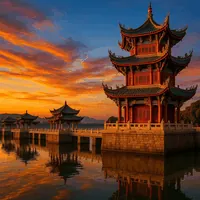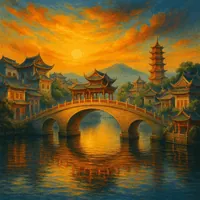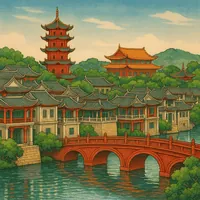


Shantou, China
Population: 4,312,192
Shantou, nestled along China's southeastern coastline, uniquely blends the bustling commerce of a major port city with the cultural richness of Chaoshan traditions. Its iconic Swatow porcelain is a testament to centuries-old craftsmanship, while the city's chaotic Jieyang Chaoshan International Airport ranks as one of the world's quirkiest, with its peculiar blend of old and new architecture. Shantou is further celebrated for its distinct dialect, Teochew, preserving linguistic nuances found nowhere else.













Notable points about Shantou
- Cultural Melting Pot: Shantou is known for its unique blend of cultures, particularly owing to its significant Teochew (Chaozhou) heritage, which influences the local language, cuisine, and architecture. This richness in cultural diversity sets it apart as a vibrant and historically rich city.
- Economic and Trade Hub: Designated as one of China’s Special Economic Zones, Shantou has a thriving economy with a strong focus on manufacturing and export, facilitating numerous business opportunities. Entrepreneurs and investors will find ample potential for growth and development here.
- Stunning Coastlines: For those looking to enjoy natural beauty, Shantou offers stunning coastlines and numerous beaches, like Jinghai Beach and Nan'ao Island. This makes it a perfect getaway for couples seeking romantic seaside views or families enjoying a relaxing day out.
- Culinary Delights: Foodies will be thrilled to experience Shantou's culinary scene, which is famous for Teochew cuisine. The dishes are known for their fresh flavors and unique preparation methods, including steaming and braising, making Shantou a paradise for gourmands.
- Bustling Night Markets: Singles and younger travelers will enjoy exploring Shantou’s bustling night markets, offering a mix of local street food, fashion, and entertainment options, providing a lively atmosphere and a chance to engage with local culture.
- Historical Sites: For history enthusiasts, Shantou presents places like the Shantou Museum and the Old Town district, filled with well-preserved colonial architecture and reflecting the city’s historical significance as a former treaty port.
- Unique Language and Customs: What makes Shantou distinct from other cities in China is its perseverance in preserving the Teochew dialect and customs among its inhabitants, offering visitors a distinctive cultural experience that differs from Mandarin-dominated cities.
- Family-Friendly Environment: With numerous parks and recreational facilities, Shantou provides a family-friendly atmosphere. Children can enjoy places like People’s Square, which offers playgrounds and open spaces for a day of fun and play.
- Accessibility and Infrastructure: The city is well-connected with a developed infrastructure, including the Shantou Waisha Airport and convenient public transportation, making it easy for travelers of all types to move around and explore nearby regions.
- Warm People and Community: Older generations might appreciate the warm and friendly community spirit in Shantou, where the locals are known for their hospitality and welcoming nature, making any visitor feel right at home.
Summarized Traveller Reviews
Shantou's Neighborhoods
Old Town (Xiaogongyuan)
🎯 Key Attractions
- Zhongshan Park: A leafy respite with shaded paths and traditional pavilions.
- Shantou Customs House: A relic of the city's treaty port era with stately colonial architecture.
- Hidden Teahouse Alley: A narrow lane where aging wooden doors open to secret tea rooms.
✨ Unique Aspects
“It feels like the walls here still hum with the voices of traders from a hundred years ago.” – Jun, local historian
Haojiang District
🎯 Key Attractions
- Haojiang Riverfront Promenade: Peaceful walking path with fishing boats bobbing nearby.
- Chenghai Ancient Bridge: Stone bridge offering views of river life.
- Morning Fish Market: Bustling dawn market where vendors greet you like family.
✨ Unique Aspects
“You can smell the sea before you see it, and the rhythm of life moves with the tide.” – Ming, retired sailor
Jinsha Area
🎯 Key Attractions
- Golden Sands Plaza: A large shopping center with both local and international brands.
- Night Snack Street: Alleyway famous for oyster omelets and beef hotpot.
- Rooftop Arcade Lounge: Retro video games with city views at night.
✨ Unique Aspects
“We came for shopping, but stayed until midnight playing arcade basketball.” – Kara, traveler from Manila
Longhu District
🎯 Key Attractions
- Shantou Museum: Exhibits on local history, including Chaoshan culture.
- People's Square: Wide open space for public gatherings and night dancing.
- Future Boulevard: An emerging street with experimental cafes and design shops.
✨ Unique Aspects
“It’s where the city breathes—mornings in the park, evenings under the lights.” – Hui, café owner
Queshi Scenic Area
🎯 Key Attractions
- Queshi Mountain Park: Trails weaving between rocky peaks and sea views.
- Seaside Cycling Path: A gentle ride along the water’s edge.
- Lighthouse View Café: Tiny coffee hut with panoramic ocean vistas.
✨ Unique Aspects
“I hiked up to watch the fishing boats head out at dawn—it felt like the day was starting just for me.” – Leo, visitor from Singapore
Waisha Area
🎯 Key Attractions
- Campus Culture Street: A hub of student-run cafes and bubble tea shops.
- Mini Amphitheater: Open-air stage for small concerts and poetry readings.
- Vinyl & Noodles: A cozy spot combining ramen bowls with classic record listening.
✨ Unique Aspects
“You can lose hours talking with strangers here, and somehow it never feels like time wasted.” – Aili, student
Shantou Bay New Area
🎯 Key Attractions
- Marina Walk: Boardwalk with views of sleek yachts and cargo ships.
- Harbor Lights Mall: High-end shopping and dining with sea views.
- Bay Breeze Terrace: Evening jazz spot overlooking the harbor.
✨ Unique Aspects
“It’s like watching a painting being painted—you can almost see the future skyline rise.” – Chen, architect
Haimen Town
🎯 Key Attractions
- Haimen Seafood Market: Bustling hall of live fish tanks and sizzling woks.
- Old Temple Pier: A quiet jetty with incense drifting from a nearby shrine.
- Fisherman’s Festival: Annual boat parade and night feasts on the docks.
✨ Unique Aspects
“I had crab so fresh it was still warm from the afternoon sun.” – Tara, food blogger from London
Lianxia Old Street
🎯 Key Attractions
- Teochew Opera House: Performances of traditional music and drama.
- Handmade Lantern Workshop: Family-run craft shop open for visitors.
- Hidden Courtyard Café: Coffee and poetry readings behind carved wooden doors.
✨ Unique Aspects
“The red lanterns make it feel like every night is New Year’s Eve.” – Yuxi, local artisan
Nan'ao Island Gateway
🎯 Key Attractions
- Ferry Terminal: Gateway to Nan'ao Island’s beaches and villages.
- Dockside Crab House: Beloved for its chili-spiced crab pots.
- Traveler’s Chalk Wall: Outdoor wall where passersby leave doodles and notes.
✨ Unique Aspects
“Even if you’re not catching the ferry, the air here smells like vacation.” – Luis, traveler from Madrid
Guang'ao Industrial Port Area
🎯 Key Attractions
- Harbor Crane Lookout: An unofficial viewpoint over the bustling port.
- Midnight Dumpling Cart: Serving steaming pork dumplings to dock workers.
- Graffiti Warehouse: Local artists’ canvas hidden among cargo depots.
✨ Unique Aspects
“It’s raw, but there’s a strange beauty in the cranes lit up against the night sky.” – Fen, photographer
Beishan Riverside
🎯 Key Attractions
- Riverside Park: Jogging paths, pedal boats, and picnic lawns.
- Tea Garden Pavilion: Outdoor tea-drinking spot shaded by banyan trees.
- Floating Bookshop: A moored boat selling books and poetry.
✨ Unique Aspects
“It’s where I learned to slow down and notice the ripples in the water.” – An, retiree




































































































